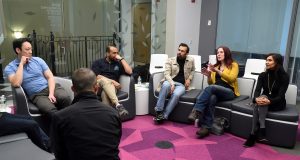“A lot of researchers are intimidated by lots of data, so they remain in methodologies where they’re comfortable. But what if there’s something better?”
Audrey Branch Johns Hopkins Kavli NDI postdoctoral fellow
It’s an abnormally quiet Thursday afternoon in Clark Hall; many of its usual inhabitants have left Hopkins’ Homewood campus for spring break. Then, from the third floor, in the Johns Hopkins Kavli Neuroscience Discovery Institute’s (NDI) glass-enclosed meeting space, comes a riot of noise.
There, Simon Allard is using a dry-erase marker to sketch a rat brain on a wall in front of a group of fellow researchers. The group — all Johns Hopkins Kavli NDI Postdoctoral Fellows — watch, listen, and ask questions as Allard shares updates on his project. One audience member mentions a new set of algorithms his lab is producing that might apply to Allard’s project. Another brings up a recent study about the influence of light strobes on neurodegeneration.
“Great! Let’s take grandma to a rave!” one fellow says, and the entire floor echoes with laughter.
The lighthearted moment underscores a significant part of what the Johns Hopkins Kavli NDI, established in 2016 by a joint $20 million commitment by Hopkins and the Kavli Foundation, hopes to accomplish in uniting researchers among neuroscience, engineering, and data science: collaboration.
“A lot of science is solitary — you’re the only one who knows your question and what you’re looking for. Through Kavli, the collaboration has been outstanding,” says fellow Audrey Branch, a neuroscientist who studies how memory circuits in the brain change with age.
“Neuroscience is going in a direction where we need better tools and methods to image the brain. This requires new devices — and engineers are developing really novel ways to do that,” explains Rick Huganir, professor and director of the Solomon H. Snyder Department of Neuroscience in the School of Medicine and co-director of the Johns Hopkins Kavli NDI. “We’re getting so much data that we don’t know how to deal with it. We need data scientists from engineering and computer science — and traditionally, we haven’t interacted too much with those domains.”
“A lot of researchers are intimidated by lots of data, so they remain in methodologies where they’re comfortable. But what if there’s something better?”
Audrey Branch Johns Hopkins Kavli NDI postdoctoral fellow
Before coming to Hopkins, Allard spent much of his young career studying age-associated neurological diseases like Alzheimer’s using biochemical approaches, which he says offer indirect measurements of neurodegeneration. He sought a more precise measurement of how neurological systems operate in vivo and, with support from his Johns Hopkins Kavli NDI fellowship, is developing a new molecular tool to do just that.
“The Kavli Institute encourages ambition by propelling very new lines of investigation, solidifying collaborative work that will, down the line, be appealing to main funding agencies,” says Allard, whose mentors are Marshall Hussain Shuler, an associate professor of neuroscience in the School of Medicine, and Michael Miller, PhD (Med ’83), MS (Engr ’78), co-director of the Johns Hopkins Kavli NDI and the Herschel and Ruth Seder Chair in the Whiting School and School of Medicine’s Department of Biomedical Engineering.

Researchers in the Center for Imaging Science, which Miller also directs, are developing algorithms to make sense of the data Allard’s tool collects. By the end of his fellowship, Allard aims to have a pool of data from which to identify the earliest functional alterations in neurological systems — even before the behavioral symptoms of neurodegeneration show up. That knowledge could increase the effectiveness of interventions and treatments.
That’s the research project that Allard is presenting today in the Johns Hopkins Kavli NDI space for the fellows’ monthly luncheon, which alternates between the institute’s spaces on the East Baltimore and Homewood campuses. The gatherings, similar in structure to a faculty meeting, not only train the researchers for future roles in academia or industry but also show them how scientists can interact and grow with each other’s feedback. They give rise to what Allard calls “microcollaborations” among the fellows and faculty.
“There are these rapid, frequent interactions we have with each other, and they really help a lot in moving our work forward,” Allard says. Without the Johns Hopkins Kavli NDI, he says, he probably wouldn’t have thought about asking an engineer to collaborate. He’s not the only one.
“A lot of researchers are intimidated by lots of data, so they remain in methodologies where they’re comfortable. But what if there’s something better?” Branch says. “I can’t dream bigger if I don’t know the possibilities of what’s out there, and Kavli helps with that.”
Follow the institute on Facebook (Kavli NDI Hopkins) and Twitter (@HopkinsKavli).
Interested in supporting innovative research collaborations like the Kavli Neuroscience Discovery Institute at Hopkins?
Topics: Foundations, Johns Hopkins Medicine, Krieger School of Arts and Sciences, Whiting School of Engineering, Fuel Discovery